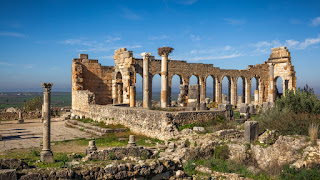The somewhat exhumed vestiges of the old city of Volubilis direct a prolific plain found roughly 22 miles (35 kilometers) north of the supreme city of Meknes. Outstanding amongst other safeguarded old locales in Morocco, the remnants offer a captivating knowledge into the city that once filled in as the capital of the realm of Mauretania, and later as one of the southernmost urban communities of the Roman Empire.
Old History
Volubilis was established by the Berber individuals in the third century BC, and was a piece of Mauretania when the realm turned into a Roman customer state following the fall of Carthage in 146 BC. In 25 BC, King Juba II was set on the seat and started assembling his imperial capital at Volubilis. In spite of his Berber family line, Juba was hitched to the little girl of Mark Antony and Cleopatra, and his preferences were particularly Roman. The city's open structures (counting a gathering, a basilica and a triumphal curve) mirror the engineering styles of Roman urban areas across Europe.
In 44 AD, Mauretania was attached by Claudius and Volubilis developed rich trading grain, olive oil and wild creatures for use in gladiatorial exhibitions to the remainder of the Empire. By the second century, the city was one of the Empire's most significant stations and flaunted 20,000 inhabitants. The wealthiest families lived in fine townhouses with stupendous mosaic floors. Volubilis was invaded by nearby clans in 285 AD and never re-caught by Rome. Rather, the city was possessed for an additional 700 years, first by Latin-speaking Christians and afterward by Muslims.
In the late eighth century, it turned into the capital city of Idris I, the originator of the Idrisid administration and the Moroccan state. By the eleventh century, in any case, the city was surrendered. The seat of intensity was migrated to Fez, and Volubilis' inhabitants moved to the close by mountain town of Moulay Idriss Zerhoun.
Volubilis in Later Years
The remnants of Volubilis stayed flawless until the mid-eighteenth century, when they were to a great extent wrecked by a quake. In the next decades, Moroccan rulers like Moulay Ismail plundered the remnants for their marble, which was utilized in the development of a few majestic structures in Meknes. The remnants were just distinguished as those of the old city of Volubilis in the late nineteenth century, when they were somewhat uncovered by French archeologists. All through the French provincial time frame, the remains were exhumed, reestablished and now and again, re-assembled.
In 1997, Volubilis was recorded as an UNESCO World Heritage Site in acknowledgment of its significance as a finely safeguarded case of a huge Roman provincial town on the edges of the Empire.
What to See
The exhumed area of Volubilis is moderately little in correlation with the antiquated city edifices of Egypt. Be that as it may, the smooth sections and disintegrating dividers make for shocking photos set against the scenery of the Moroccan open country, and meandering through the notable remnants is a lowering encounter. Make a point to visit the triumphal curve, situated at the edge of the remnants; the gathering with its transcending segments and what's left of the city's basilica. The feature of an excursion to Volubilis is without a doubt its reestablished mosaic floors, which are all visible in their unique setting.
The best of these are situated at the House of Orpheus, the biggest and generally lovely of the uncovered private houses. Here, you'll discover three dazzling mosaics delineating Orpheus playing his lute to a crowd of people of wild creatures, a dolphin and Poseidon, the Roman lord of the ocean. The house additionally incorporates the remaining parts of a private hammam, complete with hot and cold rooms and a solarium.
Step by step instructions to Visit Volulbilis
The vestiges at Volubilis are open each day from dawn to dusk. You'll have to pay a little confirmation charge of 70 dirhams, and authority guides are accessible available at the passage to the complex for 120 dirhams. The vast majority visit on a day trip from Meknes (22 miles/35 kilometers away) or Fez (50 miles/80 kilometers away). You can drive there yourself, or recruit a private taxi from the train station in Meknes. In case you're visiting from Fez, it's less expensive to take the train to Meknes and sort out a taxi from that point than to book a taxi from Fez itself. On the other hand, most riads and lodgings in the two urban areas offer composed visits to Volubilis. These generally incorporate a stop at the mountain town and holy journey site of Moulay Idriss.
Where to Stay
In the event that you need to visit for longer than a day, you'll have to book settlement at Moulay Idriss, found only five kilometers from the Volubilis ruins. There are a determination of environmental guesthouses and B&Bs to browse - including top of the line alternative Dar Zerhoune. Housed inside a customary Moroccan home, this B&B offers ensuite visitor rooms, a café that represents considerable authority in credible Moroccan food and a rooftop patio with amazing perspectives on Moulay Idriss and the remnants in the valley past. Visitors can join day by day strolling visits from the B&B to Volubilis, going through olive forests and nearby towns en route.
When to Go
Volubilis is an advantageous goal throughout the entire year, and there is no terrible time to visit. Nonetheless, the mid year months can get unfathomably sweltering, and there is little insurance from the sun in the antiquated city. In the event that you decide to visit from June to August, make a point to bring a lot of water and sunscreen. The city is at its generally beautiful in April and May when the encompassing fields are lavish with spring wildflowers. For the best photos, attempt to time your visit for early morning or late evening, when delicate light plates the segments of the old city with gold.

Social Plugin